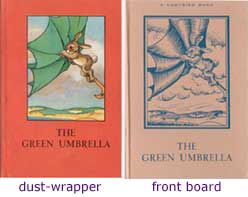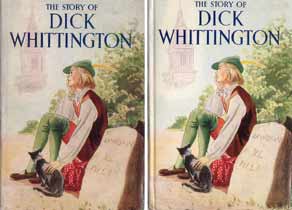Ladybird books, between 1940 and 1980, have
had a few varying formats but have always managed to maintain
a uniformed-look in size and style.
The
standard pocket-sized Ladybird
book is 7 inches tall and 4.75 inches
wide. Each book consists of 52 pages made from one large
sheet of paper measuring 40 inches by 30 inches - see
picture opposite.
Some early editions had 56 pages with the extra pages
carrying catalogue information and copyright dates.
The
books were protected with stiff-card boards. Early editions
of the first series,
401, up to series
497
are found to have a picture pasted to their front boards
or were fully pictorial. Editions in series
522 and onwards are found with a more simple
(often blue ink) illustration on their front boards.
|

| A
printed Ladybird book before it was folded and sewn
- taken from The Story of Printing
found in series 601 |
|
| Pre-1965
books were all published with dust-wrappers which usually
had the original price of 2'6 printed on the front inside
flap. The dust-wrapper's back inside flap usually held
a list of all other titles within the books series.
|
 |
The
Tinker's Wig
A book that breaks free from the standard Ladybird
book format is the one-and-only title of series 478 entitled
The Tinker's Wig.
This book was twice the size of the common Ladybird
book and had 93 pages rather than the usual 52 pages.
It also broke the usual printing style by setting text
on both sides of the pages and used less pictures than
all the other books. |
Annual
size
In the late 1970s, and on later occasions, Ladybird
published a few annual size books - these were not a great
success and were not published in high numbers or reprinted
to any great extent.
Ladybird Picture Word Book, pictured
on the right, was published in 1980 and illustrated by
Lynn N Grundy. The book measures 12 x 8.75 inches
and has 60 pages.
Unlike all other Ladybird books this
title does not belong to a series but is a one-off publication.
|
 |
Mini Mention
Although we are only focusing on pre-1980s
Ladybird books in this part of our website
it is worth mentioning that Ladybird published a mini series
of fairy tales in the 1980s. These small books were half the
size of the standard Ladybird book.
 |
Up until 1961 Wills
& Hepworth used the open-winged Ladybird
logo on their books - an example of this can be seen on
the left. If your book has this logo then it is from 1961
or before. |
In 1961
the logo was changed to the closed-winged ladybird, which
can be seen on the right. If your book has this logo then
it is from 1961 or later.
Both these logos are usually found in the middle of the
front flyleaf, opposite the title page, as well as at
the top of the back inside flap of the dust-wrappers.
|
 |
| Post
1961 the logo could be found in the middle of the dust-wrapper's
back cover. |

 |
Perhaps the most commonly recognised Ladybird
logo of all is the one shown on the left.
|
| This
logo first appeared in 1965 and was printed
on the front board, usually in the top right
corner and on very early matt editions it
was sometimes placed in the bottom right corner.
See the books above for examples of this |
|
|
Other
logos used by Ladybird books
 |
This
logo was introduced to Ladybird books in the early
1970s. |
| This logo was used
on books throughout most of the 1970s and some of
the 1980s |
. |
|
 |
Illustrated
board formats
Underneath the dust-wrappers of early editions in series
401 can be found small illustrations pasted to the front
boards.
See the image on the right for an example of this. |
These
illustrations were the same as the ones found on the dust-wrappers
- these were pasted on by hand and subsequently some are
found to be a little squint.
These small pasted illustrations were unique to series
401 and series
497 which included titles such as Ned
the Lonely Donkey and The
Conceited Lamb. |
Later
editions from the 1950s had the pasted illustrations replaced
by a simple lined impression of the dust-wrapper illustration.
The image on the right shows the dust-wrapper and the
front board of an early 1960s edition of The
Green Umbrella, from series
401 |
 |
| Sometimes
the lined illustrations are found in blue, green, brown
or black ink. |

| A
3rd edition from 1950 of The Story of Dick
Whittington, showing dust-wrapper and pictorial
front board to be the same. |
|
413, 455, 474 and series 538 were published with full
picture boards that were gloss-coated - the illustrations
on the front boards were identical to the dust-wrappers
that protected them.
Reprints
of these books kept the pictorial boards up until 1956
and then were replaced with lined illustrations instead.
|
|
Books that were printed with pictorial boards are found
to have glossy pages which made them a better quality
than later editions.
|
|
|
| Random
fact |
|
Illustrator Martin Aitchison was paid just £21 per illustration for his first book, 'A First Book of Saints' (1963) - by 1975 this had risen to £60 per illustration |
|
